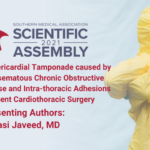Abstract | November 8, 2021
A Case of Extrapericardial Tamponade caused by Bullous Emphysematous Chronic Obstructive Pulmonary Disease and Intra-thoracic Adhesions following recent Cardiothoracic Surgery
Learning Objectives
- Discuss extrapericardial tamponade as extrinsic compression on the pericardial cavity causing decreased ventricular diastolic filling and subsequently poor cardiac output;
- Identify prior known etiologies of extra pericardial tamponade as hematoma following surgery or trauma as well as herniation following esophagectomy;
- Diagnose extrapericardial tamponade by echocardiography and treat extrapericardial tamponade acutely through urgent intervention including surgery.
Introduction: Cardiac tamponade is a well-documented condition usually caused by accumulation of fluid in the pericardial cavity. Extrapericardial tamponade is a life-threatening and very rare condition, which is sparsely mentioned in literature and has only a few reported etiologies. This case is the first unique case to our knowledge of extrapericardial tamponade secondary to bullous emphysematous chronic obstructive pulmonary disease and intra-thoracic adhesions, which resulted in near catastrophic cardiac and respiratory compromise.
Case Presentation: 69-year-old Male, with a past medical history significant for chronic obstructive pulmonary disease, atrial fibrillation, and tobacco abuse disorder, presented due to shortness of breath, orthopnea, and non-productive cough. Notably, only one week prior, he underwent ablation for atrial fibrillation, complicated by perforation of the left superior pulmonary vein for which he underwent repair of the left superior pulmonary vein and left atrial junction by cardiothoracic surgery. Even at that time, surgery had noted expansive lung architecture creating difficulty in viewing the heart.
Significant vitals included blood pressure 70/40 mmHg and oxygen saturation 96% on 2L nasal cannula. On exam, he had decreased breath sounds bibasilarly, jugular venous distention, and mild end-expiratory wheezing diffusely. Significant initial laboratory findings included troponin 0.17 and pro-brain-type natriuretic peptide 5073.
Final/Working Diagnosis: Extrapericardial tamponade secondary to bullous emphysematous chronic obstructive pulmonary disease and intra-thoracic adhesions after cardiothoracic surgery
Management/Outcome/Follow-up: The patient later required intubation. Emergency bedside thoracotomy was performed but the heart was not well-visualized. So, emergency cardiothoracic surgical exploration was performed. On the mediastinal approach, lung tissue was observed to be compressing the pericardial cavity. The right lung crossed the midline with dense adhesions to the left lung, pericardium, and the posterior plate of the sternum. The adhesions were then lysed at these points of contact and the lung was reduced. The patient was extubated the next day and successfully recovered.

